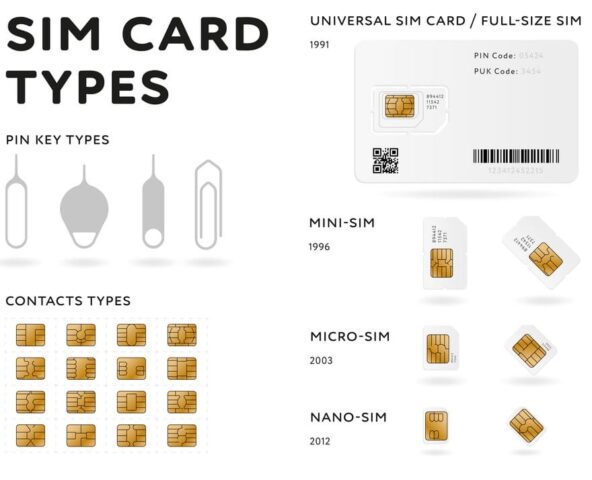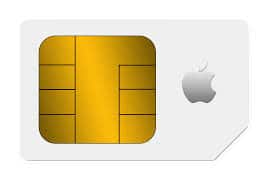In this technological epoch, communication with your near and dear ones has become bed of roses. As being a technophile, we have heard about the SIM card, how it looks like. However, what does it stand for and what are its types? So here we are going to study about SIM card and its detail.
What is a SIM Card?
SIM stands for Subscriber Identity Module. A SIM card is a tiny, portable memory chip that stores information about you as a cell phone user. On it, there’s a 17–digit code that designates its country code of origin, the system carrier and a unique user ID.
You may wonder, “Who cares about this code?†A valid question and guess what: a phone carrier do. It’s how they attribute cell phone bills and charge us. SIM cards are also capable of storing information, such as contact list data and SMS messages. Most SIM cards have capacity of between 32KB to 128KB. Transferring this data mainly involves removing the SIM card from one phone and inserting it into another, though this has become less important with the advent of backup apps.
How does SIM card works?
The most important bits of data include the IMSI (International Mobile Subscriber Identity) and the authentication key that validates the IMSI. The carrier provides this key.
SIM authentication goes like this:
- On startup, the phone obtains the IMSI from the SIM card and relays it to the network. Think of this as the “request for access.”
- The network takes the IMSI and looks in its internal database for that IMSI’s known authentication key.
- The network generates a random number, A, and signs it with the authentication key to create a new number, B. This is the response it would expect if the SIM card is legitimate.
- The phone receives A from the network and forwards it to the SIM card, which signs it with its own authentication key to create a new number, C. This number is relayed back to the network.
- If the network’s number A matches the SIM card’s number C, then the SIM card is declared legitimate and access is granted.
Types of SIM card

There are three basic sizes of SIM card: the standard, the micro and the nano.
The standard SIM
Of the three, the standard is the oldest SIM that were used before 2010 and only a few have been issued thereafter. It measures 25X15mm. Today, they are mainly used on older phones.
›
Micro-SIM
Wanting to save precious room for its newest generation of smartphones. Apple switched from using the standard SIM to the Micro-SIM once the iPhone 4 hit shelves.
Surprisingly, the Micro-SIM wasn’t some new flashy SIM developed for the latest iPhone. Believe it or not, it was first introduced in 2003 and it measures 12x15mm.
Back then, its purpose was clear: if a device was too small to fit a mini-SIM, you’d have to use the micro-SIM. In addition, the micro-SIM was designed for backward compatibility. It can work with input generated by an older version of the SIM (such as the Mini-SIM).
In addition, despite its smaller size, the micro’s performance wasn’t impacted at all, as chip’s contact area remained the same. It turned out to be scaled down – the card only needed its excess plastic to be cut from it.
When Apple released the iPhone 4 with the micro-SIM, it became the standard for most smartphones. Samsung, Nokia, and HTC are just a few of the manufacturers that adopted the new Micro-SIM. During this time, several upgrading to the iPhone 4 opted to use an adapter to get their SIM cards cut down to Micro’s, as well. Although their usage has stopped, they are still used in few handsets today.
Nano-SIM
If you thought Apple was done using smaller SIM cards, think again. Perhaps Apple was peeved they had to use a SIM card from 2003 on the shiny new iPhone 4 . Maybe they just wanted to stay ahead of the curve and throw competitors off their trail. It measures around 12.3×8.8mm.
In any case, the launch of the iPhone 5 prompted the public to realize there was a new SIM in town: the Nano-SIM. This choice to go small made life pretty difficult for users. Anyone upgrading to an iPhone 5 or switching from Android now had to get a new SIM card or an adapter.
Fortunately, most smartphones released since 2014 (both iOS and Android) now support Nano SIM card technology as the standard. Still, it’s sad to see a card that small take over, as it was always much easier changing phones with the Standard SIM compared to the Nano.
eSIM and Soft SIM
Now where will the SIM card go in the future? Judging from the trend, it’ll likely to be the size of a speck of dust, so insignificant that you wouldn’t even feel it in your hand.
No, I’m joking that would be horrible. But get this; next version of the SIM likely will be impossible to hold. That’s because it is entirely virtual. They are the next carnation of the SIM card we’ll see, a software “card†that carries all of the SIM’s original functions without any of the plastic or brass hardware bits.
One cool aspect of this new class of SIMs is that subscribers are able to switch operators easily, without swapping the physical SIM card. Software-based cards are the answer when it comes to the hassles that came with switching phones over the years.
The use of embedded SIMs (eSIM) and Soft SIM are starting to gather pace. These technologies break down the geographical barrier when it comes to mobile connectivity between different countries, and open doors to new form factors. Next, billions of Internet of Things (IoT) will be connected worldwide- and just like people travel from country to country. eSIM and Soft SIM will play a crucial role on how quickly and seamlessly all those things connect too.
But despite its conveniences, the eSIM and soft SIM have their fair share of detractors.One potential risk that has been raised by networks regarding these SIMs is the issue of security and ability to be reprogrammed.This may be potentially problematic for those who wish to not be tracked as phone devices with an active SIM card can easily be tracked by the network.
Apple SIM

In 2014, alongside the iPad Air 2 and iPad mini 4, Apple unveiled Apple SIM, a way for the company to offer dynamic network choice to its customers without the hassle of getting SIMs from multiple carriers. Apple SIM allows iPad owners to connect to compatible networks in over 180 countries; in the U.S., those carriers include AT&T, Sprint, and T-Mobile. Though the Apple SIM is manufactured by Apple, you still purchase plans from a specific carrier using your credit card — there’s no iTunes billing option.
The beauty of Apple SIM is its ability to interface with multiple networks. If your local providers support it, you can swap between network plans depending on which one makes the most sense for your needs. For instance, you can swap between Sprint and T-Mobile if you go from a Sprint-heavy part of the country to someplace where T-Mobile’s network reigns. When traveling internationally, you can also use Apple partners GigSky, AlwaysOnline Wireless, and au to purchase per-day or per-megabyte bundles to save on roaming costs.
All current-generation iPads have an empty nano SIM slot and an additional embedded Apple SIM card. As a result, you can use the embedded Apple SIM if you choose, or pop in a new SIM without losing access to Apple SIM’s carrier-switching features.
History of SIM card.
It is a small mighty device that has changed the face of communication. Sim Card was created in 1991 by Munich smart – card maker Giesecke & Devrient. He sold the first 300 SIM cards to the Finish wireless network operator Radiolinja. It’s a chip that has seen several iterations over the years. Sim card size got reduced from a credit card to a postage stamp. Today, SIM card are ubiquitous, allowing over 7 billion devices to connect to cellular networks around the world.
Pros and Cons of SIM Card
Pros
1. Cost Efficiency
With these SIM cards, the pay you go data bundles is way cheaper as compared to the other plans. You have the freedom to choose which package suits you best, and if you find that your usage exceeded the limit, you are free to purchase some more.
2. Flexibility
With monthly bundle plans, it doesn’t tie you to long – term contract. No one wants the same amount for more than a year. Things change all the time, therefore, you need a plan that can offer you the flexibility to change with the times.
3.Smart great networks
The networks benefits that come with data SIM-only deals are just as great as any other deals. You can access 4G internet speed anyway, like any other data user from any different plan.
4. Retaining your existing number.
Getting data SIM only deals doesn’t mean that you have to get a new number unless you want to. You can remain with your current digits by contacting your current provider with the request. They can furnish you with a Port Authentication Code (PAC). With that code you can contact your new data SIM- only provider and quote the number the new SIM card comes with.
Cons
However, as every coin has two sides, there are some disadvantages.
1. Expensive handsets.
Since you’re getting your handset separately from your SIM by yourself and not a contract, you’ll part with a hefty amount at a go.
2. Locked handset
Some providers lock their handset to their network. Ergo, it becomes an arduous task for you to lose their handset with another SIM provider. However unlocking is usually in most cases free of charge, but some provider levy a certain amount of fee.
Conclusion
To bolster, SIM card is extremely secure and ideal for Banking Application. As every year technology is flourishing by leaps and bounds, there are lot more iteration need to come. Ergo, lets hope to see the magnificent changes that come in our day-to-day lives.
















